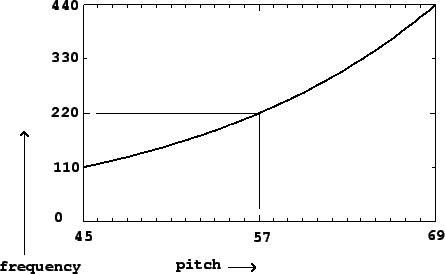Perhaps the most frequently used operation on electronic sounds is to change
their amplitudes. For example, a simple strategy for synthesizing sounds is by
combining sinusoids, which can be generated by evaluating the formula on Page
![]() , sample by sample. But the sinusoid has a constant
nominal amplitude
, sample by sample. But the sinusoid has a constant
nominal amplitude ![]() , and we would like to be able to vary that in time.
, and we would like to be able to vary that in time.
 |
In general, to multiply the amplitude of a signal ![]() by a factor
by a factor ![]() , you can just multiply each sample by
, you can just multiply each sample by ![]() , giving a new signal
, giving a new signal ![]() . Any measurement of the RMS or peak amplitude of
. Any measurement of the RMS or peak amplitude of ![]() will be greater
or less by the factor
will be greater
or less by the factor ![]() . More generally, you can change the amplitude by an
amount
. More generally, you can change the amplitude by an
amount ![]() which varies sample by sample. If
which varies sample by sample. If ![]() is nonnegative and if
it varies slowly enough, the amplitude of the product
is nonnegative and if
it varies slowly enough, the amplitude of the product
![]() (in a
fixed window from
(in a
fixed window from ![]() to
to ![]() ) will be related to that of
) will be related to that of ![]() by the
value of
by the
value of ![]() in the window (which we assume doesn't change much over the
in the window (which we assume doesn't change much over the ![]() samples in the window).
samples in the window).
In the more general case where both ![]() and
and ![]() are allowed to take
negative and positive values and/or to change quickly, the effect of multiplying
them can't be described as simply changing the amplitude of one of them; this is
considered later in Chapter 5.
are allowed to take
negative and positive values and/or to change quickly, the effect of multiplying
them can't be described as simply changing the amplitude of one of them; this is
considered later in Chapter 5.